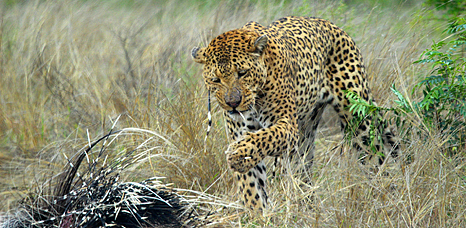Andrew Milligan travelled on our 'South Africa - Kruger (Mammals)' tour and submitted this entry to our writing competition.
Leopard with Porcupine by Samantha Jones
Last month (October 2012) I returned from my third visit to the Kruger with Naturetrek. I am sometimes asked whether I don’t just see the same animals every time. Well, of course, I do, but as keen birders it is not just a matter of another tick on the list but, more importantly, of stopping and observing animal behaviour - even of ‘familiar’ animals. There is also the chance of better sightings of creatures already encountered and, of course, it is very exciting to see a ‘new’ animal. This year’s safari accomplished all three of these.
The journey from the airport to the Kruger and back took us over the high veld and this afforded closer sightings of both Blesbok and Black Wildebeest. The former, a fairly large antelope, is very striking with its white facial blaze which extends from its horns down to its mouth. The latter, a very large antelope, black in appearance with a white, horse-like tail, is the gnu of the song ‘I’m a gnu, a gnother gnu’. It was wonderful to have better closer views of these.
The high veld also revealed two ‘new’ animals to me, the Grey Rhebok, a small graceful antelope, and a ‘new’ mongoose, the Yellow Mongoose. We spotted this creature, reddish-yellow, hence its name, in the grass beside the road before it ran across in front of us - then it sat up and looked at us in the classic pose of a Meerkat.
In the Kruger National Park itself we caught glimpses of a Cape Clawless Otter. Here otters are rarely seen and so we were very fortunate. Early one morning (the camp gates open at 5.30am) we were at a dam observing the Hippos when our attention was attracted by a pair of Blacksmith Plovers behaving in a very agitated manner. It was then that we saw the otter swimming near them. Was it planning to steal eggs or chicks from a nest hidden from our view? Alas, we shall never know, but it was a wonderfully exciting start to the day.
Arguably, even more exciting were the Honey Badgers we encountered at Satara, our first camp. Last year we had seen the results of their nocturnal activity when they had overturned some rubbish bins in search of food, as foxes used to do here but the creatures themselves had gone. This year as we were leaving the restaurant after dinner, we saw a pair busily digging a hole and we stopped to watch them for some time. I should have liked to get closer but we were advised to keep our distance for they are vicious carnivores and have been known to inflict nasty injuries on larger animals, including humans! As their name Honey Badger suggests, they are partial to raiding bees’ nests but this evening, we think, they were after ants and termites. When we inspected their work the next morning we were amazed to discover that the hole was a good metre deep!
Everyone hopes to see a Leopard and we were no exception! Though not rare, Leopards are rarely seen for they are mainly solitary and nocturnal and so the sighting of one during the morning was a special thrill. We were driving between two camps, Satara and Skakuza, when we saw on the right hand side of the road a car with a Leopard next to it. At first I thought there had been an accident and that the car had hit the Leopard. Another member of our party thought that the Leopard might have tried to attack one of the occupants of the car through the open window!
We were both wrong. In fact besides the car and the Leopard there was a porcupine between the car’s wheels and the Leopard was pulling it out. It appeared that the Leopard had been pursuing the porcupine, which had run into the road and under the car which had enabled the Leopard to catch it. We watched as the Leopard dragged the porcupine out from under the car with a front paw, then bite it to kill it. But porcupines have quills, long quills, and in catching and killing its prey the Leopard had got one or two of these quills in its face and, with its right-hand front paw, was trying to brush the quills out. We watched as the Leopard dragged the porcupine off the road and into the bush.
Alas, we shall never know whether the Leopard was successful in removing the porcupine quills from its face. I hope it did. This was certainly the highlight of our safari and, like many an incident on safari, we were just lucky to be there at that time. A few minutes earlier or later and this encounter could have been missed. This is what makes wildlife-watching such a thrill!
Read more abour our 'South Africa - Kruger (Mammals)' holiday.



 Loading search...
Loading search...
